#tino sehgal
Photo
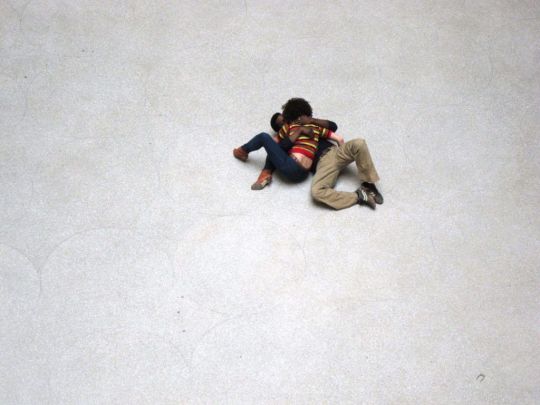
Tino Sehgal, The Kiss, 2010
the Guggenheim Museum
69 notes
·
View notes
Text

From Gustav Klimt and Auguste Rodin to Tino Sehgal and Tracey Emin
11 notes
·
View notes
Text
Parigi, 22 agosto. Sarebbe davvero bello se invece che verso la catastrofe ambientale pressoché certa, il mondo scoprisse una nuova stagione come quella prefigurata da “Echo2” di Philippe Parreno (con la collaborazione di Tino Sehgal, Arca, Nicolas Becker, Bronze) installazione che troneggia sotto la imponente rotonda della Bourse de Commerce di M.sieur Pinault. Il sole (quello vero) che gioca con il monolite elettronico di Parreno dove compare, fantasmatica, “Annelee” (il personaggio virtuale del film “Anywhere Out of the World). L’aria fresca insufflata meccanicamente invade l’enorme spazio espositivo e grazie all’intelligenza artificiale viene ricreato un microclima ideale ma del tutto artificiale. Compare persino la neve, quella che depositata formava i ghiacciai che tra poco saranno anch’essi un lontano ricordo. Chissà che sia poi davvero questo il nostro destino…
2 notes
·
View notes
Text
Sustainability in Art
This was a really interesting read as it discusses the many ways artist can be more considerate of the planet when creating their art. This can include carbon footprints when shipping art, using recycled materials and reducing waste through using more digital software. The last point is something I can relate to as I am producing digital outcomes.
0 notes
Text

Tino Sehgal
For Sehgal, an artwork consists of a live encounter between artwork and viewer. Sehgal does not make objects; he creates ‘situations’ within the museum space, in which interpreters enact choreographed actions and occasionally converse with visitors. These encounters offer the visitor a wholly unique experience of live artwork.
0 notes
Text
How contemporary artist have created networks as a means of sustaining their artistic practice?
Performance network
cyberspace
Network Fever, Mark Wigley
Artist's Network:
-a way to think about the geography of the art history
-a method for exploring performance practice
-interconnectivity of artists
-the need to form communities
Does art creation of art space as necessary to form the performance community?
Look also:
Selling the unsellable: Bringing Experiantial and Ephemeral works of contemporary art to market, Noah Horowitz
-Tino Sehgal-Constructed Situations: process-oriented artmaking, distancing the idea of the author, the economy of the art, dematerialization/immaterial
-Lea Vergine, Body and Performance
0 notes
Text
London Art Dealer Joseph Nahmad, Scion of a Powerful Collecting Family, Pleads Guilty to Assaulting His Girlfriend
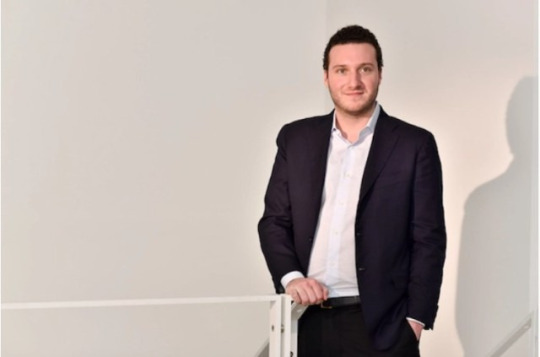
The dealer comes from one of the world's most prominent art dynasties and runs Nahmad Projects in London.
London art dealer Joseph Nahmad, who runs the Mayfair gallery Nahmad Projects, has pleaded guilty to assaulting his girlfriend.
In March, Nahmad attacked his girlfriend, Georgia Barry, at his London home in what prosecutor John Fairhead described in the Evening Standard as a “considerable beating—banging her head against the wall.” Nahmad, who is 31, also pleaded guilty to attacking Barry during another incident in October.
He pleaded not guilty, however, to an alleged attack that took place at the nightclub Tape London, and that charge has since been dropped. “There was an incident in a nightclub where a scratch and bruise were sustained. Very minor injuries,” Nahmad’s attorney, William Clegg, told the Southwark Crown Court.
Clegg also told the court that Barry had previously tried to withdraw her allegations against Nahmad, who said in a statement: “She was in a consensual, loving relationship that at times became toxic.”
Joseph Nahmad comes a long line of powerful art collectors and dealers. (Christie’s honorary chairman Christopher Burge once said the family, which has one of the world’s largest collections of Impressionist, Modern, and contemporary art, had “sold more works of art than anybody alive.”) He is the son of Monaco-based art collector Ezra Nahmad and the nephew of billionaire dealer David Nahmad. Another dealer named Joseph Nahmad, who runs the gallery Nahmad Contemporary in New York, is his cousin. Their galleries are not related.
The latest incident is not the first time that members of the younger Nahmad generation have found themselves in legal trouble. Helly Nahmad, Joseph Nahmad’s cousin in New York, was sentenced to a year in prison in 2014 for his role in a $100 million illegal gambling ring.
Nahmad Projects, the London gallery that Joseph opened with Italian dealer Tommaso Calabro in 2016, is known for pairing historic works by masters such as Jean Tinguely and Pierre-Auguste Renoir with contemporary artists, like Jason Rhoades. Its inaugural show, organized by the celebrated curator Francesco Bonami, presented performance art inspired by the work of Tino Sehgal.
Joseph Nahmad pleaded guilty to two charges of assault occasioning actual bodily harm. He is currently out on bail until his next court appearance on September 2, where he could be sentenced to serve time in jail.
0 notes
Text
Commonplace_v9
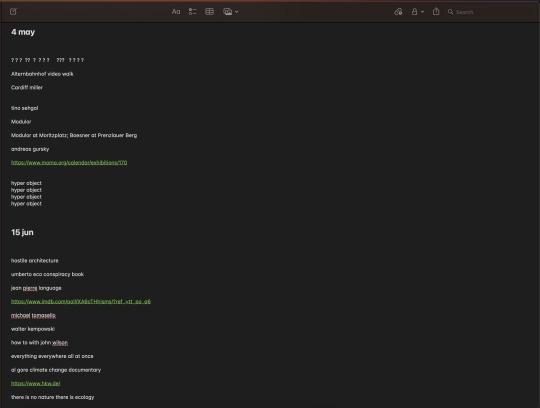
4 may
? ? ? ?? ? ? ? ? ??? ? ? ? ?
Alternbahnhof video walk
Cardiff miller
tino sehgal
Modulor
Modulor at Moritzplatz; Boesner at Prenzlauer Berg
andreas gursky
hyper object
hyper object
hyper object
hyper object
15 jun
hostile architecture
umberto eco conspiracy book
jean pierre language
michael tomasello
walter kempowski
how to with john wilson
everything everywhere all at once
al gore climate change documentary
there is no nature there is ecology
peter thiel new zealand
zheng bo
temporal dimension
carolyn tomato documentary
0 notes
Text
Tino Sehgal
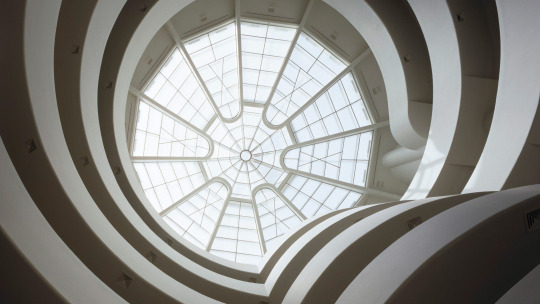
Focusing on the fleeting gestures and social subtleties of lived experience rather than on material objects.
Presented as part of the Guggenheim’s 50th Anniversary celebrations, Sehgal’s exhibition comprised a mise-en-scène that occupies the entire Frank Lloyd Wright–designed rotunda.
He had people walking the circle having conversations with guests. The conversation starts with a child, teen, adult then elderly. The conversations were of nothing in particular but its a journey and i think its really lovely.
Sehgals works cant be pictured but have a bug effect on people. I really think this piece works as movement as its moving through time, place and conversation.
I would like to take inspiration from Sehgal as he uses just the act to create art. I am thinking of documenting my daily activities with videos, conversations and day to day sights.
0 notes
Text
The award has been given to 13 artists since its founding and it has catapulted artists already at the top of the game to even further heights in the art world. The winners for the prize have been Matthew Barney (1996), Douglas Gordon (1998), Marjetica Potrč (2000), Pierre Huyghe (2002), Rirkrit Tiravanija (2004), Tacita Dean (2006), Emily Jacir (2008), Hans-Peter Feldmann (2010), Danh Vo (2012), Paul Chan (2014), Anicka Yi (2016), Simone Leigh (2018), and Deana Lawson (2020). Lawson’s win, announced in October 2020, was considered major at the time as she was the first photographer to win the award.
Each of those artists was selected from a shortlist of other artists. Those rosters have been often star-studded, including artists like Cecilia Vicuña, Kevin Beasley, Cai Guo Qiang, Laurie Anderson, Maurizio Cattelan, Vito Acconci, Tino Sehgal, Damián Ortega, Patty Chang, Camille Henrot, Laura Owens, Wu Tsang, Teresa Margolles, and Ralph Lemon, who was announced as the winner of the Whitney Museum’s $100,000 Bucksbaum award earlier this week.
0 notes
Text
TINO SEHGAL - Artist Research
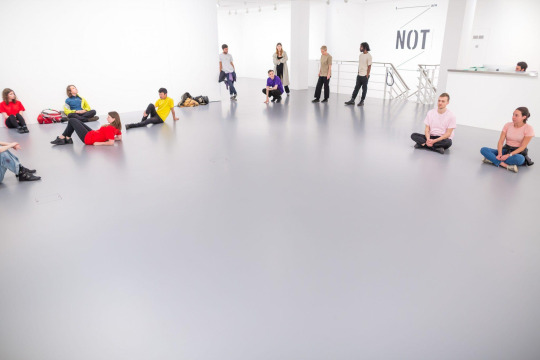

Shannon briefly mentioned Sehgal to me the other day so thought I'd have a quick google.
"Tino Sehgal is an artist of German and Indian descent, based in Berlin, who describes his work as "constructed situations".[1] He is also thought of as a choreographer who makes dance for the museum setting" - Wikipedia
"Tino Sehgal constructs situations that challenge conventional art-and-spectator relationships, focusing on the fleeting gestures and social subtleties of lived experience rather than on material objects" - https://www.guggenheim.org/artwork/artist/tino-sehgal
Sehgal believes there are already too many objects and things in the world so explores and works within "producing meaning and value through a transformation of actions rather than solid materials" - https://www.guggenheim.org/artwork/artist/tino-sehgal .
Sehgal also doesn't allow photographs, videos or any kind of documentation of his work where it has the potential to be bought and/or sold.
I like the idea of these 'constructed situations' that aren't documented. I document all of my work and collaboration with participants - whether this is through the final paintings or photographing/ filming the process. It does make me wonder how I can continue looking into the same themes and topics but without documenting them. Does it just become the collaborative experience that's the artwork? The shared experience of stimulation in my experiments? Something to consider and Seghal is someone to look into a bit more in depth for next semester!
0 notes
Photo

Ye & Tino Sehgal, featured in 032c
#kanye west#ye west#ye#tino sehgal#032c#sunday service#donda#yeezy#donda2#032c magazine#photography#westsubever
32 notes
·
View notes
Text
Tino Sehgal
Tino Sehgal es un artista de ascendencia alemana e india, con sede en Berlín, que describe su trabajo como "situaciones construidas". También es considerado como un coreógrafo que baila para el ambiente del museo.
Fecha de nacimiento: 1976 (edad 44 años), Londres, Reino Unido
Educación: Universidad Humboldt de Berlín, Universidad Folkwang de las Artes
Nominaciones: Premio Turner, Hugo Boss Prize
Venice Biennale (in 2005, together with Thomas Scheibitz). Sehgal had solo exhibitions at a number of important venues including the Stedelijk Museum, Amsterdam (2015); Museum für Moderne Kunst, Frankfurt (2007); the Institute of Contemporary Arts, London (2007, 2006, 2005); Kunsthaus Bregenz, Austria (2006), Kunstverein Hamburg (2006), Serralves Foundation, Porto (2005); Van Abbemuseum, Eindhoven and Musée des Beaux-Arts, Nantes (2004).[6]
#hombre#performance#t#s#tino sehgal#alemania#india#artista aleman#premio turner#turner#turner prize#coreografo#biennale venezia#stedelijk#amsterdam#frankfurt#institute of contemporary arts#kuntsverein hamburg
1 note
·
View note
Text
Resuscitation of the Authentic: Art Against Documentation
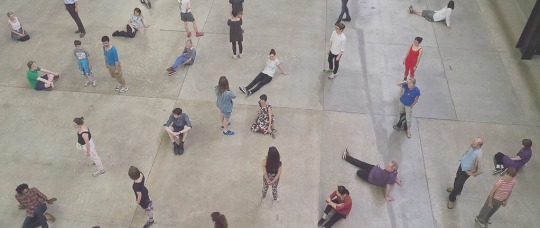
In the summer of 2013, the light and space artist, James Turrell requested that visitors of his exhibition at the Solomon R. Guggenheim Museum, refrain from taking any photographs. Turrell, who had created a new installation, Aten Reign (2013), for this exhibition, believed that glowing mobile devices would impede on the meditative atmosphere of his work, which sought to recast the rotunda of the Guggenheim into a volume filled with shifting artificial light, a soft diffusion of pink, blue and yellow. In spite of, or perhaps because of Turrell’s provocative request, more than 5000 photos from this exhibition appeared on social media platforms such as Instagram and Facebook, with the hashtag: “Turrell.” Indeed, in 2013 by the close of the show, this exhibition became the “most Instagrammed” in Guggenheim history. A similar event occurred in 2012 when Tino Sehgal, an artist known for his works featuring live encounters, was commissioned by the Tate Modern for their Unilever Series (2012), where he introduced a series of performances titled These Associations (2012). Sehgal, too, requested that the performances not be photographed or documented in any way, in keeping with his larger investment of being strictly against producing the art object. However, much like the Turrell exhibition, with a simple google search, one can find on social media platforms such as Flickr and Vimeo, countless numbers of photographs, videos, and posts that users have uploaded from their experience of these performances.
These artists rehearse an attachment to singularity and presence that characterizes not only much of contemporary performance art, but also one that is prominent in marketing practices. Companies advertise their products through the idea of the authentic experience-one that produces an idea of desire through singularity. In marketing, the inauthentic is something amnesic, prepackaged, and monotonous. Modern day companies use social media platforms like Instagram and Twitter to produce advertisements that may seem more personable, “the impulse to capitalize on popular trends and reach audiences on their own terms often drives brands to improperly use cultural idioms or otherwise present themselves and their products in a manner deemed "inauthentic”“. What is at stake in such a resuscitation of authenticity? Might this new fetish for the authentic function as being a significant post-digital cultural formation? Marketingland provides a rundown of how to be an "authentic brand” through what they’re claiming to be behavior analysis science insights to “help brands create authentic content that engages audiences without inspiring cynicism and mistrust, ” all the capital without the criticism. This begs the question of attachment: is there an attachment of the authentic to the real? It is clear that there is a relationship that is unavoidable, one that associates the authentic to the self-made. The inauthentic seems to be identified as a threat to individuality and is understood as either machine-made or being attached to technology.
The authentic is one that elevates the human above the machine. As Ruskin understands it, the machine is something that can only make inauthentic things - dead things that communicate their deadness to those who use them. However, this doesn’t account for the human behind the machine. In Wretched of the Screen, Hito Steyerl addresses this question of the human behind the machine. The situation an image is created or reproduced in reveals more than the context or appearance of the image. Through sharing, screenshots, downloads, and reposts, the image or digital file reveals the conditions of their marginalization and the social forces that lead to their circulation.
Arguing against Ruskin’s “the machine can only communicate deadness”, the human behind the machine is one that communicates a situation, a contemporary human condition. Through the use of digital media, we are communicating life. Through the performance of a photo, the individual is communicating place and representation. A selfie is a means of saying “I was there”, a production of evidence (connected to surveillance culture and race politics). Visual culture is a social relationship through images. The image is a product of social relations that produces contradictory side effects. The image has become ideological, it teaches us what to think and additionally influences our choices and how we interact socially. The power of spectacle culture captivating/overwhelming is self-validating of commodity culture and continues to establish itself as a driving force in determining both private and public desires This leads me to ask: can an experience be real/authentic without the production of an image?
Wil S. Hylton, "How James Turrell Knocked the Art World Off Its Feet," The New York Times, June 13, 2013, accessed March 02, 2018, http://www.nytimes.com/2013/06/16/magazine/how-james-turrell-knocked-the-art-world-off-its-feet.html.
TEDxTalks, YouTube, March 02, 2016, accessed March 07, 2018, https://www.youtube.com/watch?v=8DLNFDQt8Pc&t=175s.
Sean Santiago, "Inside the Apartment of An Instagram Celebrity," Inside the Apartment of a #Selfie-Made Celebrity, June 5, 2015, accessed March 07, 2018, https://www.refinery29.com/jiajia-fei-guggenheim-interview.
Ignacio Villarreal, " Tate unveils first live commission in The Unilever Series created by the artist Tino Sehgal," Artdaily.org, July 24, 2012, accessed March 02, 2018, http://artdaily.com/news/56696/Tate-unveils-first-live-commission-in-The-Unilever-Series-created-by-the-artist-Tino-Sehgal.
Flickr search "Turrell 2013": https://www.flickr.com/search/?structured=yes&text=james%20turrell%202013
Flickr search "Sehgal These Associations": https://www.flickr.com/search?text=tino%20seghal%20these%20associations&structured=yes
#essay#art#authenticity#james turrell#performance#media#marketing#arts criticism#article#tino sehgal
1 note
·
View note

